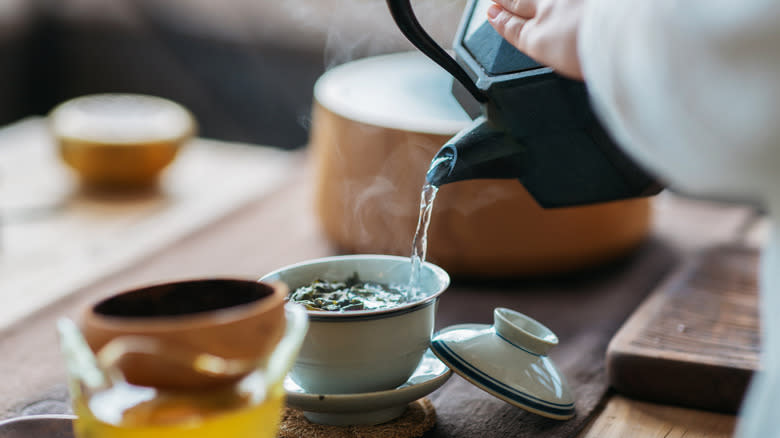Why Natural Bottled Water Is The Best Option For Your Cup Of Tea

Lao Tzu himself famously called tea "the elixir of life," but to the poet Lu Yu, the matter of tea was a bit more complicated than that. In 760s China, folks were predominantly enjoying their tea leaves in elaborate soups. They were eating them instead of drinking them. To influence his contemporaries that tea could be a flavorful drink on its own, Yu wrote the seminal "The Classic of Tea" (aka the "Ch'a Ching") in which he stressed the importance of brewing tea with high-quality ingredients like pure spring water.
According to Yu's prescription, "The best quality tea must have creases like the leathern boot of Tartar horsemen, curl like the dewlap of a mighty bullock, unfold like a mist rising out of a ravine, gleam like a lake touched by a zephyr, and be wet and soft like a fine earth newly swept by rain," and as you might guess, just "any water" will not do. Still, somewhere along the way, contemporary foodies have lost their way. At its fundamental level, tea is flavored water. In such a minimal beverage, ingredients count extra. In the same way that using impure water is among the biggest mistakes you're making with ice cubes, the type of water you use to make tea can make a big difference in your lovin' mugful's overall flavor. The best water for steeping a good cup of tea is water that is low in minerals and natural bottled water is the best tool for the job.
Read more: 15 Boba Flavors, Ranked Worst To Best
Extend The Same Reverence To Your H2O As You Do Your Tea

Hard (aka mineral-rich) water can impart a harsh metallic or even dull taste into your tea Calcium, chlorine, fluorine, and iron don't belong in your tea. Making sure your water has a low fixed residue amount is key. In bottled water, the fixed residue amount (FRA) should be printed on the label. If your particular bottle doesn't list the FRA, track down a brand that does. Opting for neutral-tasting water can also allow the subtler notes in your tea leaves to shine, creating a dimensional cup that's like a rich symphony.
As you scout out bottled water in the grocery store, look for brands with a pH of 7 and an FRA of 30 parts per million or less. In the same vein, at-home pH test strips can be useful here, too. If your tap water totes a pH above 7 (neutral), it needs to be filtered before going into your cuppa tea. In general, if you don't drink your tap water straight up, don't try to make tea with it. Also, among the things you should know about microplastics in bottled water is that where you store your bottles matters. Be sure to store your bottled water away from direct sunlight to avoid BPA contamination. Alternatively, for avid tea drinkers, you could skip the single-use plastic bottles and invest in a Brita-filtered pitcher to keep neutral-tasting water on hand whenever the tea mood strikes.
Read the original article on Tasting Table.

